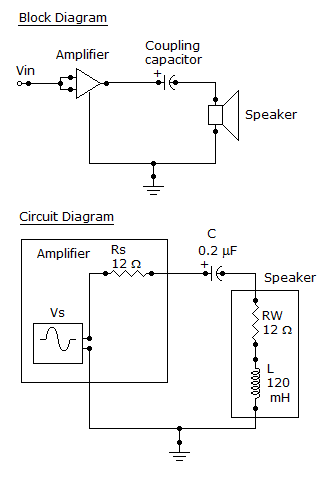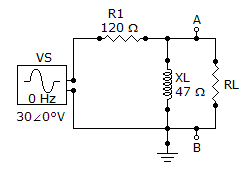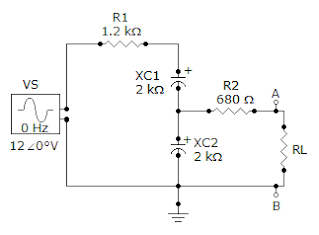Practice Test: Question Set - 01
1. Determine VTH for the circuit external to RL in the given figure.
- (A) 135 ∠63.4°
V
- (B) 13.5 ∠63.4°
V
- (C) 13.5 ∠0°
V
- (D) 135 ∠0°
V
2. A Thevenin ac equivalent circuit always consists of an equivalent ac voltage source and an equivalent capacitance.
- (A) True
- (B) False
3. Referring to the given circuit, how much power, in watts, is delivered to the speaker at the determined frequency if VS = 4.5 VRMS?
- (A) 226 mW
- (B) 2.26 mW
- (C) 4.24 mW
- (D) 424 mW
4. Like Thevenin's theorem, Norton's theorem provides a method of reducing a more complex circuit to a simpler, more manageable form for analysis.
- (A) True
- (B) False
5. If two currents are in the same direction at any instant of time in a given branch of a circuit, the net current at that instant
- (A) Is zero
- (B) Is
the sum of the two currents
- (C) Is
the difference between the two currents
- (D) Cannot
be determined
6. Referring to the given circuit, what is ZTH if R1 is changed to 220 Ω?
- (A) 225
∠12.1° Ω
- (B) 225
∠77.9° Ω
- (C) 46 ∠77.9° Ω
- (D) 46 ∠12.1° Ω
7. Norton's theorem provides a method for the reduction of any ac circuit to an equivalent form consisting of an equivalent voltage source in series with an equivalent impedance.
- (A) True
- (B) False
8. Thevenin's theorem provides a method for the reduction of any ac circuit to an equivalent form consisting of an equivalent current source in parallel with an equivalent impedance.
- (A) True
- (B) False
9. Norton's theorem gives
- (A) An
equivalent current source in parallel with an equivalent impedance
- (B) An
equivalent current source in series with an equivalent impedance
- (C) An
equivalent voltage source in parallel with an equivalent impedance
- (D) An
equivalent voltage source in series with an equivalent impedance
10. One circuit is equivalent to another, in the context of Thevenin's theorem, when the circuits produce the same voltage.
- (A) True
- (B) False
11. Referring to the given circuit, determine ZTH as seen by RL.
- (A) 1444 ∠-48.5° Ω
- (B) 4176 ∠-73.3° Ω
- (C) 956 ∠-48.5° Ω
- (D) 1444 ∠-73.3° Ω
12. Referring to the given circuit, what is VTH if VS = 12 ∠0° V?
- (A) 4.69 ∠38.7°
V
- (B) 9.38
∠38.7° V
- (C) 12 ∠0°
V
- (D) 6 ∠0°
V
13. Determine the frequency at which the maximum power is transferred from the amplifier to the speaker in the given figure.
- (A) 1,027 Hz
- (B) 10,270 Hz
- (C) 6,330 Hz
- (D) 63,330 Hz
Next Tests:






